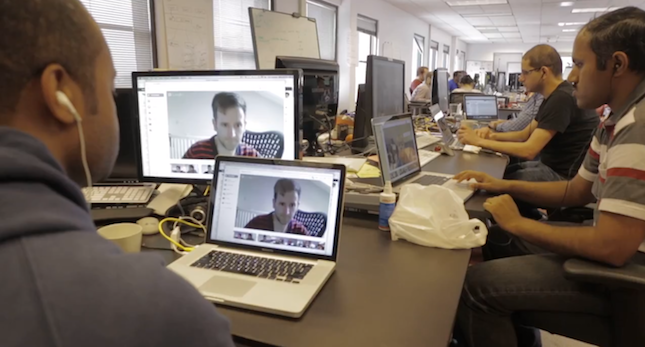
Distributed teams and avoiding face time bias
Companies rarely promote people into leadership roles who haven’t been consistently seen and measured. It’s a familiarity thing, and it’s a trust thing. We’re not saying that the people who get promoted are stars during every “crucible” moment at the office, but at least they’re present and accounted for. And their presence says: Work is my top priority. I’m committed to this company. I want to lead. And I can.
- Jack and Suzie Welch in a 2007 Business Week column
After all the hullabaloo about Yahoo eliminating its work from home policy I thought a lot about how distributed work is part of everyday life on many Thoughtworks teams. It’s certainly true for our Mingle team where we have a pair of great developers who are based in the UK while the rest of the team is based in San Francisco.
Face-time bias or Why you need to be seen.
At the heart of the issue seems to be the concept called "face time bias" where in-office staff are given more access, higher raises and other preferential treatment over their distributed colleagues.Google tells me that Face Time and the Unspoken Bias Behind Nontraditional Work Cultures - UC Davis Graduate School of Management (more detailed version) is the most reputable/referenced public article on the subject. On reading it, I was initially a bit put off with their “tip”, as it seems to come from a place of distrust:
Furthermore, there can be an underlying suspicion towards how their time is spent regardless of the quality of their work
I would like to think that we start from a position of trust with all of our co-workers. However, the detailed version provided a bit more context. They note that there are two kinds of passive face time:
- Expected face time - which is simply being seen at work during normal business hours
- Extracurricular face time - which is being seen at work outside of normal business hours
These two kinds of face time bias lead to different kinds of trait inferences. The authors ran experiments and the results were interesting but perhaps not surprising:
The results were clear and robust across multiple samples: Managers were 9% more likely to unconsciously attribute the traits “dependable” and “responsible” to people who put in expected face time and 25% more likely to unconsciously attribute the traits “committed” and “dedicated” to people who put in extracurricular face time. These results were statistically significant across each of our experiments. - MIT Sloan Management Review
Perhaps the troubling thing about face time bias is that it is usually unintentional or even unconscious. So if the best of us may be guilty of committing face time bias what can we do to avoid it?
How do you battle the bias?
I like to think that implicit trust and our style of working help us to avoid the pitfalls of face time bias e.g:

- Daily video hangouts: We use Google Hangouts every day for our cross office stand ups. We also use Google Hangouts on Air. Due to the timezone differences between SF and the UK our dev pair in the UK start their day when those of us in SF are still asleep. We had numerous issues where end of day emails failed to properly capture the key issues that our friends in the UK should be aware of to start their day. We’re now in the habit of recording a stand up video at the end of the day in SF and sharing the video with the pair in the UK. This allows the UK team get a very contextual view of the issues they should be aware of to start their day and because it’s just a stand up for the SF team the video is very easy to produce.
- Remote pairing: To keep help with information flow and maintain a healthy communication dynamic we regularly pair on stories between SF and the UK. Admittedly these sessions aren’t long due to the limited working day overlap but we feel the benefits make it worthwhile.
- Result-based progress monitoring: Daily checkins and story ownership/progress are inherently result-based rather than trait-based. We, of course, use Mingle to maintain a digital kanban board. This helps us visualize our development pipeline so we’re able to see how each team member is contributing to the value creation process.
Based on a *very* informal poll, we think that our culture and the way we work helps us avoid face time bias. While we don’t know if there’s a silver bullet for avoiding face time bias on a distributed team our experience suggests that visibility, via video to help human interaction, and visibility via a simple virtual card wall to show work progress, seem to go a long way.
Disclaimer: The statements and opinions expressed in this article are those of the author(s) and do not necessarily reflect the positions of Thoughtworks.














